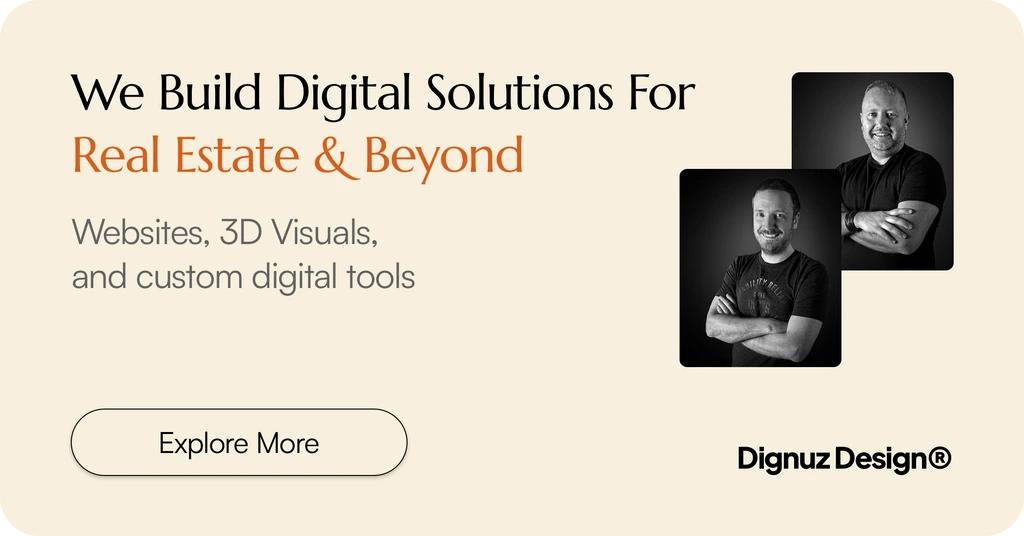JAM-stack E-commerce

Benefits, Challenges, and Why It's the Future of E-Commerce
Online stores need speed. Shoppers expect instant page loads and smooth checkout experiences. The technology powering your e-commerce site directly affects these factors. JAMstack architecture offers a fresh approach to building faster, more secure online stores.
JAMstack combines JavaScript, APIs, and Markup to create high-performing websites. This architecture separates the frontend and backend, allowing each to operate independently. The result? Sites that load almost instantly and scale effortlessly.
For e-commerce businesses, this technology shift presents exciting opportunities. Better performance leads to higher conversion rates. Improved security protects both you and your customers. Let's examine why JAMstack matters for modern e-commerce and how it could transform your online presence.
What Is JAMstack Architecture?
JAMstack represents a modern web development approach. It stands for JavaScript, APIs, and Markup. This architecture fundamentally changes how websites are built and delivered.
The name breaks down into three core components:
- JavaScript: Handles all dynamic functionality in the browser
- APIs: Connects your site to external services via reusable interfaces
- Markup: Pre-built HTML content served from CDNs (Content Delivery Networks)
Unlike traditional approaches, JAMstack separates the frontend presentation from backend processes. This decoupling creates significant advantages. Your content gets pre-rendered during the build process, not when users request it.
This pre-rendering process creates static HTML files. These files get distributed to CDNs around the world. When users visit your site, they receive content from the nearest server. This approach eliminates database queries and server processing on each visit.
For e-commerce specifically, JAMstack can handle product displays, content pages, and blog sections with exceptional speed. The checkout process typically runs through APIs connected to your payment processor.
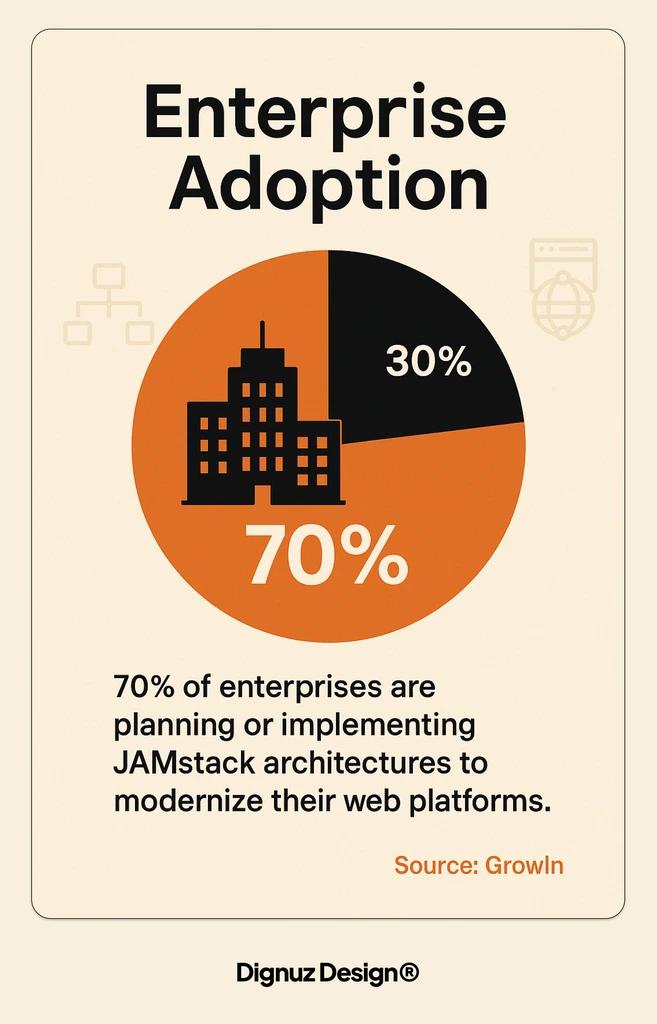
Benefits of JAMstack for Ecommerce
JAMstack architecture offers several key advantages for online stores. These benefits directly address common e-commerce pain points.
Enhanced Performance
Speed sells in e-commerce. 70% of enterprises are planning or implementing JAMstack architectures to modernize their web platforms. (Source: GrowIn) This adoption rate demonstrates the recognized performance benefits.
Customer patience continues to decrease. 53% of users abandon websites that take more than 3 seconds to load, a risk mitigated by JAMstack's pre-rendered content and CDN delivery. (Source: eSpark Info) This statistic highlights the direct connection between site speed and business results.
JAMstack sites achieve this performance through several mechanisms:
- Pre-rendered content eliminates server processing time
- CDN delivery places content closer to users
- Minimal JavaScript enhances interactivity without slowing initial load
- No database queries during page requests
For ecommerce businesses, these speed improvements directly impact conversion rates. Faster pages keep shoppers engaged throughout the purchase journey.
Improved Security
Security concerns keep ecommerce owners awake at night. JAMstack addresses these worries through a fundamentally different approach to site architecture.
Traditional e-commerce platforms expose multiple potential attack vectors. These include server vulnerabilities, database injections, and plugin weaknesses. JAMstack reduces these attack surfaces by eliminating traditional servers and databases from the runtime environment. (Source: Dev.to)
The security benefits include:
- No direct connection between frontend and database
- Reduced server-side dependencies
- Fewer potential points of failure
- API-based connections with proper authentication
These security advantages protect both your business and customer data. The architecture makes it inherently harder for attackers to compromise your site.
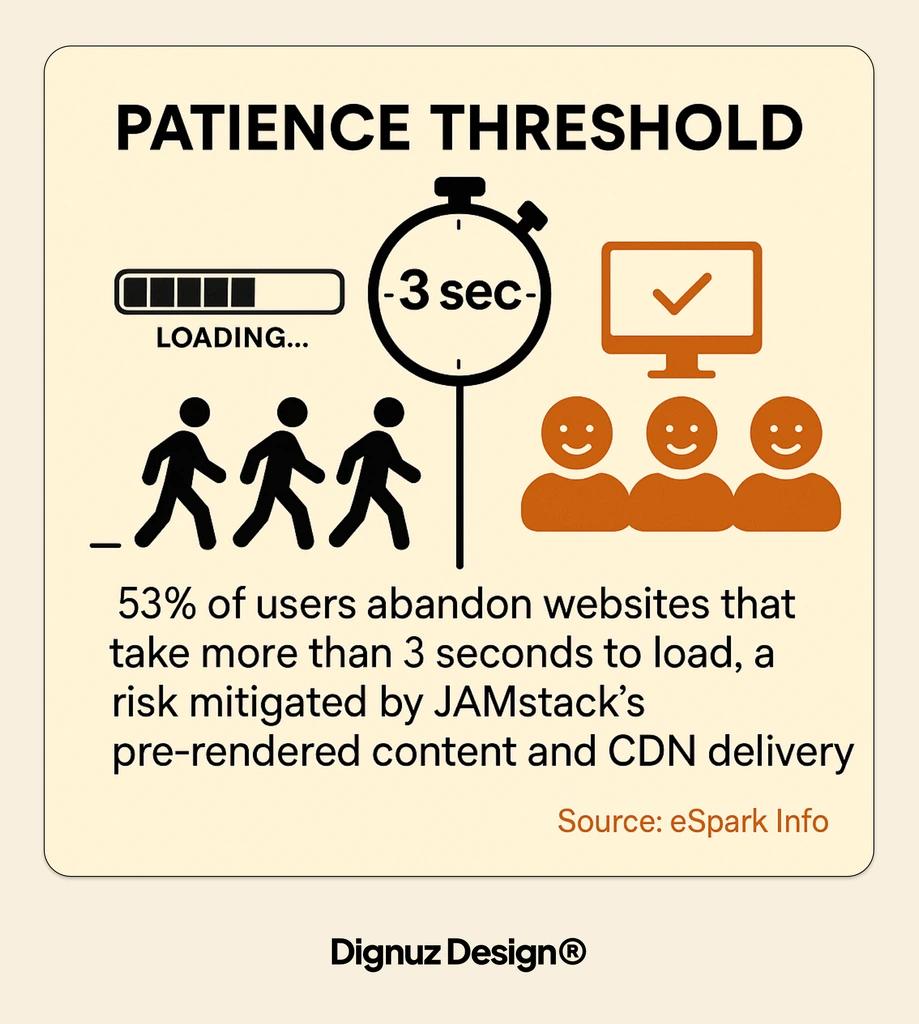
Superior Scalability
Traffic spikes represent both opportunity and challenge for ecommerce sites. Holiday sales, promotions, or viral products can send visitor numbers soaring. Traditional sites often crash under unexpected loads.
JAMstack sites scale effortlessly through CDN infrastructure. Providers like Vercel, Netlify, and Cloudflare Pages handle millions of requests without requiring backend infrastructure upgrades. (Source: Datrycs)
The scalability benefits include:
- Automatic scaling during traffic surges
- No server provisioning or load balancing required
- Consistent performance regardless of visitor count
- Global reach through distributed CDN nodes
This inherent scalability eliminates the need for complex infrastructure planning. Your site remains fast regardless of traffic volume.
Enhanced Developer Efficiency
The technical team building your e-commerce site affects both initial and ongoing costs. JAMstack improves developer efficiency through modern workflows and clear separation of concerns.
JAMstack's decoupled architecture allows independent frontend and backend development workflows. (Source: Ikius) This separation enables specialized teams to work without blocking each other.
The architecture also integrates seamlessly with headless CMSs like Contentful and Sanity, along with API-first ecommerce platforms such as Shopify and BigCommerce. This ecosystem provides flexibility in choosing the right tools for specific needs.
For e-commerce businesses, these efficiency gains translate to:
- Faster development cycles
- Easier maintenance and updates
- More flexible technology choices
- Reduced developer frustration
The result is a more agile development process that adapts quickly to changing business needs.
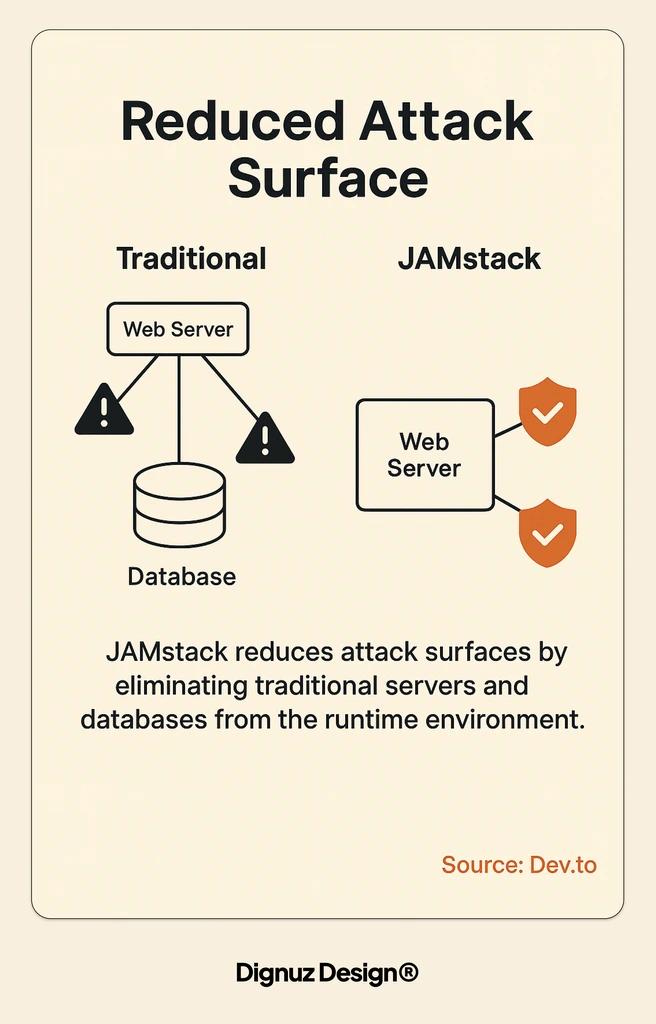
JAMstack vs. Traditional Ecommerce
Understanding how JAMstack compares to traditional ecommerce architectures helps clarify its advantages. The following table highlights key differences between these approaches.
Page Loading
- JAMstack E-commerce: Pre-rendered content delivered from CDNs
- Traditional E-commerce: Server-generated content on each request
Performance
- JAMstack E-commerce: Faster loading through CDNs and pre-rendering
- Traditional E-commerce: Slower due to server-side rendering
Scalability
- JAMstack E-commerce: CDN-driven scaling without backend changes
- Traditional E-commerce: Requires server upgrades and infrastructure planning
Security
- JAMstack E-commerce: Minimal attack surface with no runtime database
- Traditional E-commerce: Vulnerable through server dependencies and databases
Deployment
- JAMstack E-commerce: Build once, deploy globally to CDN
- Traditional E-commerce: Complex deployment to servers with potential downtime
Development Workflow
- JAMstack E-commerce: Decoupled frontend and backend development
- Traditional E-commerce: Often tightly coupled development processes
Content Updates
- JAMstack E-commerce: Requires rebuild for content changes
- Traditional E-commerce: Immediate updates through database
Cost Structure
- JAMstack E-commerce: Often lower hosting costs with predictable scaling
- Traditional E-commerce: Higher infrastructure costs that increase with traffic
This comparison highlights the fundamental differences in approach. JAMstack prioritizes performance and security through architectural choices. Traditional systems offer simpler content updates but face greater challenges with performance and scaling.
For most ecommerce businesses, the JAMstack advantages outweigh the challenges. The performance benefits directly impact conversion rates, making it a compelling option for growth-focused businesses.
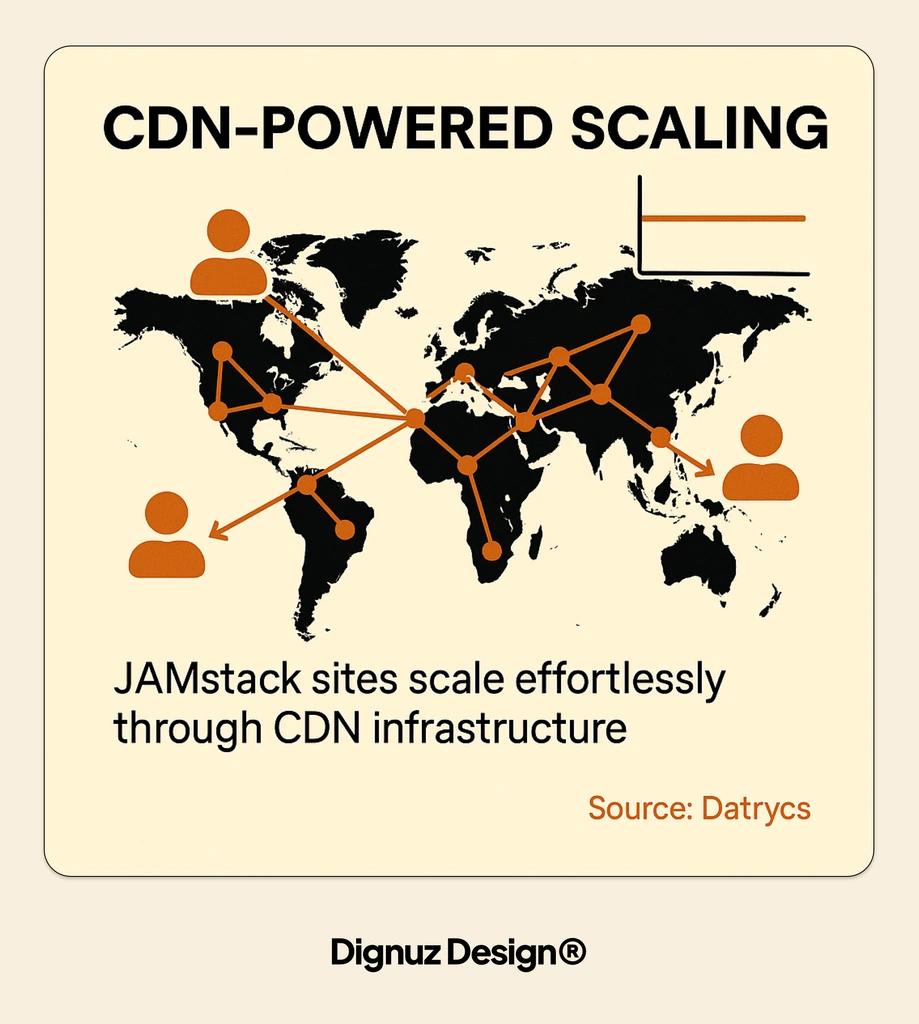
Key Components of JAMstack Ecommerce
Building a JAMstack e-commerce site requires understanding the core technical components. Each element plays a specific role in creating a complete system.
Frontend Framework
The frontend framework provides the structure and interactivity for your store. Popular options include:
Next.js
- Key Features: Static generation, server-side rendering options, React-based
- Best For: Larger ecommerce sites needing SEO optimization
Nuxt.js
- Key Features: Vue-based static generation, simplified routing
- Best For: Teams with Vue.js experience
Gatsby
- Key Features: GraphQL data layer, extensive plugin ecosystem
- Best For: Content-rich stores with many integrations
Astro
- Key Features: Partial hydration, framework-agnostic
- Best For: Maximum performance optimization
Remix
- Key Features: Server components, nested routing
- Best For: Complex UI requirements
Choosing the right framework depends on your team's expertise and specific requirements. Next.js currently dominates for ecommerce implementations due to its flexibility and performance characteristics, similar to how Webflow provides specific advantages for web design projects.
Headless CMS
Content management remains essential for product descriptions, blog posts, and marketing pages. Headless CMS systems separate content creation from presentation, fitting perfectly with JAMstack architecture.
Contentful:
- Type: SaaS
- Strengths: Enterprise-ready, powerful content modeling
Sanity:
- Type: SaaS
- Strengths: Customizable editing interface, real-time collaboration
Strapi:
- Type: Self-hosted
- Strengths: Open-source, complete control, customizable API
Prismic:
- Type: SaaS
- Strengths: Visual editing, slice machine components
WordPress + API:
- Type: Hybrid
- Strengths: Familiar interface, extensive plugin ecosystem
Each CMS option offers different tradeoffs between ease of use, flexibility, and cost. Your choice should align with your content management needs and team capabilities.
Ecommerce Backend
The e-commerce functionality requires specialized systems for product management, inventory, and checkout. Several approaches exist:
Shopify Headless
- Approach: API-based commerce using Shopify infrastructure
- Best For: Merchants needing reliable backend with custom frontend
BigCommerce
- Approach: API-first commerce platform
- Best For: Complex catalog and enterprise requirements
CommerceLayer
- Approach: API-only commerce platform
- Best For: International businesses needing order management
Saleor
- Approach: Open-source GraphQL commerce API
- Best For: Custom implementations requiring full control
Medusa
- Approach: Open-source composable commerce
- Best For: Developers needing customizable commerce engine
The ecommerce backend handles critical functions like cart management, checkout process, payment processing, and order fulfillment. These systems provide APIs that connect seamlessly with your JAMstack frontend.
Implementing JAMstack for Ecommerce
Moving from theory to practice requires careful planning and implementation. The following process outlines key steps for building a JAMstack ecommerce site.
Implementation Timeline
The implementation process typically follows these phases:
Planning: 2-4 weeks
- - Requirements gathering
- - Technology selection
- - Architecture design
- - Content modeling
Development: 8-12 weeks
- - Frontend framework setup
- - Component development
- - CMS integration
- - Ecommerce API connections
Content Migration: 2-6 weeks
- - Product data import
- - Content creation
- - Media optimization
- - SEO implementation
Testing: 2-3 weeks
- - Performance testing
- - User acceptance testing
- - Payment processing verification
- - Cross-browser compatibility
Launch: 1 week
- - DNS configuration
- - CDN optimization
- - Analytics setup
- - Monitoring implementation
Post-Launch: Ongoing
- - Performance monitoring
- - Conversion optimization
- - Content updates
- - Feature enhancements
This timeline varies based on project complexity, team size, and specific requirements. Smaller stores might complete the process faster, while enterprise implementations may take longer.
Technical Considerations
When implementing JAMstack for e-commerce, several technical considerations require attention:
First, build performance matters. As your product catalog grows, build times can increase. Implementing incremental builds helps manage this challenge.
Second, dynamic features present unique challenges. Some e-commerce features require dynamic functionality like real-time inventory checking, personalized recommendations, user-specific pricing, and shopping cart persistence.
Third, content updates need careful planning. Deciding how and when content updates trigger rebuilds prevents delays in publishing new products or promotions. Powerful integrations between systems can streamline this process.
Fourth, search functionality often requires specialized solutions. Product search typically needs dedicated systems like Algolia, MeiliSearch, or Elasticsearch integrated via API.
Finally, authentication systems must be considered. Customer accounts and protected areas need secure authentication compatible with the stateless architecture.
Challenges and Solutions
While JAMstack offers significant advantages, it also presents unique challenges for ecommerce implementations. Understanding these challenges helps develop effective solutions.
Complex Initial Setup
Transitioning from monolithic systems requires rearchitecting workflows and integrating multiple services. This complexity can intimidate teams new to the approach.
Several solutions can address this challenge. Start with a proof-of-concept for a single section of your store. Use specialized JAMstack e-commerce starters to accelerate setup. Consider partnering with experienced JAMstack developers initially. Implement gradually rather than attempting a complete replatforming.
Dynamic Content Requirements
E-commerce sites often need dynamic elements like personalization, real-time inventory, and user-specific pricing that challenge the static nature of JAMstack.
To overcome this limitation, implement hybrid rendering approaches that combine static and client-side elements. Use edge functions for personalization logic. Leverage client-side API calls for dynamic data. Consider incremental static regeneration for inventory updates.
Build Time Management
Large product catalogs can lead to extended build times, potentially delaying content updates and product launches.
Managing build times requires specific strategies. Implement incremental builds to update only changed content. Use distributed build systems for parallel processing. Optimize image processing pipelines. Consider on-demand builders for rarely accessed content.
Search Implementation
Ecommerce sites require robust search functionality that static sites don't inherently provide.
Address search challenges by integrating specialized search services like Algolia or Elasticsearch. Implement faceted filtering through API-based solutions. Use instant search interfaces for improved user experience. Consider hybrid approaches for complex search requirements.
Future Trends in JAMstack Ecommerce
The JAMstack approach continues to evolve, with several emerging trends shaping its future in ecommerce.
Server Components and Streaming
Frontend frameworks are increasingly adopting server component models that blend static and dynamic rendering. Next.js and similar frameworks now support streaming server components that maintain performance while enhancing dynamic capabilities.
This evolution addresses one of the primary limitations of purely static approaches. Server components allow parts of pages to render dynamically while maintaining the performance benefits of static content for other elements.
Edge Computing Integration
Edge computing brings processing closer to users, complementing the CDN delivery model of JAMstack. Frameworks now support edge functions that execute close to users without requiring full server infrastructure.
This capability enables personalization without performance penalties, regional compliance features, dynamic pricing based on location, and real-time inventory checks without central server calls.
Edge computing represents a natural evolution of the JAMstack approach, maintaining its performance benefits while adding dynamic capabilities.
Incremental and On-Demand Building
Build performance challenges are being addressed through incremental approaches. Rather than rebuilding entire sites for each change, modern systems rebuild only affected pages, generate pages on first request, prioritize critical pages during builds, and implement intelligent caching strategies.
These approaches maintain the benefits of pre-rendering while eliminating long build times for large catalogs.
Composable Commerce Integration
The composable commerce movement aligns perfectly with JAMstack principles. This approach breaks monolithic ecommerce platforms into specialized, best-of-breed services connected through APIs.
JAMstack frontends serve as the ideal presentation layer for composable commerce systems. They connect seamlessly to specialized services for product information management, order processing, customer data platforms, payment processing, and inventory management.
This integration trend accelerates the adoption of JAMstack in larger ecommerce implementations.
JAMstack for Real Estate: Practical Applications
The JAMstack architecture offers particular benefits for real estate websites and applications. These advantages align closely with the industry's specific needs.
Visual Performance Benefits
Real estate marketing relies heavily on visual content. JAMstack's performance optimizations ensure smooth delivery of high-resolution property images, 3D virtual tours, interactive floor plans, and video walkthroughs.
These visual elements load quickly through CDN delivery and optimized asset pipelines, preventing the frustrating experience of waiting for media to display. This performance advantage is essential when creating detailed 3D models of real estate properties that typically include large file sizes.
Integration with Interactive Visualization Tools
JAMstack sites integrate seamlessly with interactive property visualization tools. Similar to AmplyViewer's 3D visualizations, these tools provide immersive experiences directly within websites without compromising performance.
The architecture supports WebGL-based 3D renderings, interactive property comparisons, virtual staging applications, and neighborhood exploration tools. These interactive elements enhance property marketing while maintaining site performance through efficient resource loading.
Mobile Optimization for On-the-Go Buyers
Real estate browsing increasingly happens on mobile devices. JAMstack's performance benefits are particularly valuable on mobile connections, where page speed directly impacts engagement, data limitations affect user experience, battery life considerations matter, and intermittent connectivity challenges traditional sites.
The architecture delivers fast, reliable experiences across all devices, ensuring potential buyers can access property information anywhere. This aligns with the philosophy that custom real estate websites outperform template solutions in delivering optimized user experiences.
SEO Advantages for Property Listings
Property discovery often begins with search engines. JAMstack sites offer significant SEO advantages for real estate marketing through consistently fast loading times (a ranking factor), clean HTML structure for better indexing, structured data implementation for rich results, and excellent Core Web Vitals scores.
These SEO benefits increase visibility for property listings in competitive markets, driving more qualified leads to real estate businesses.
Conclusion
JAMstack architecture represents a significant advancement for ecommerce websites. Its focus on performance, security, and scalability addresses critical challenges facing online stores today.
The approach delivers concrete benefits through its architectural principles: pre-rendered content served from global CDNs, separation of frontend and backend concerns, API-based connections to specialized services, and elimination of runtime server dependencies.
For businesses considering ecommerce platform options, JAMstack provides compelling advantages. The performance improvements directly impact conversion rates and user satisfaction. Security benefits protect both business and customer data. Scalability ensures consistent experiences regardless of traffic volume.
While implementation requires careful planning and technical expertise, the resulting benefits justify the investment. As the architecture continues to evolve, it increasingly addresses dynamic content needs while maintaining its core performance advantages.
Whether you're building a new ecommerce presence or considering a platform migration, JAMstack deserves serious consideration. Its alignment with modern web standards and user expectations positions it as an excellent foundation for current and future ecommerce needs.
